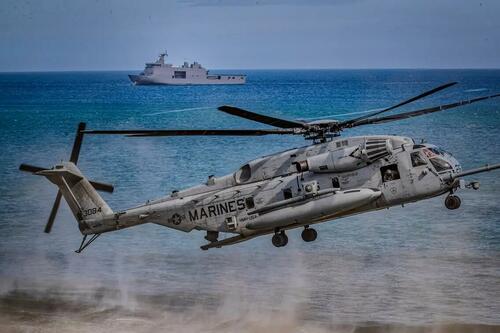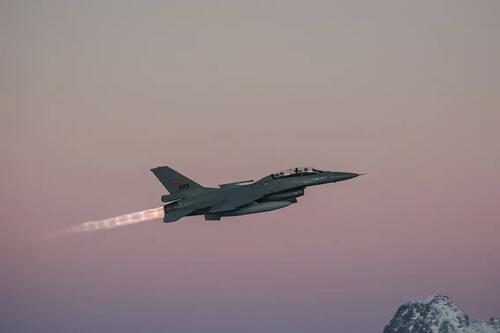
Authored by Terri Wu via The Epoch Times (emphasis ours),

When the White House released its second Indo-Pacific strategy in February 2022, senior officials said “no region will be more vital to the United States in the future and that American security and prosperity fundamentally depend on that of the Indo-Pacific.”
Two weeks later, Russia invaded Ukraine. Then, last October, Hamas attacked Israel. In late May, the United States and Germany allowed Ukraine to strike targets on Russian soil using weapons they supply. Anticipating the move from the United States and other NATO countries, Russian President Vladimir Putin warned that a third world war has “crept up unnoticed.”
The United States is simultaneously entangled in escalated conflicts in all three security fronts—Europe, the Middle East, and the Indo-Pacific—and the nexus of foreign adversaries—China, Russia, Iran, and North Korea—is coming together like never before.
Meanwhile, China has kept up its gray zone tactics in the South China Sea, harassing ships from other countries without triggering their defense treaties with America. Various U.S. military leaders, including Adm. John Aquilino, former Indo-Pacific Commander who retired in early May, have warned that China intends to be ready to invade Taiwan by 2027.
Russia and China have significantly increased their military spending to be on a war footing. They announced their “no limits” partnership shortly before Russia’s invasion of Ukraine and reaffirmed it in May.
China and Russia have been strengthening their naval cooperation through joint drills in the Indo-Pacific, and the fourth China-Russia-Iran joint military exercise was conducted in the Arabian Sea two months ago.
Iran has supplied drones to Russia, and North Korea has sent artillery rounds. The United Nations warned in April that Iran was “weeks rather than months” away from having enough highly enriched uranium to make nuclear bombs.
Have the two regional wars and the associated emergencies distracted the United States from its priority in the Indo-Pacific? U.S. government officials say “no.”
“We have not taken our eye off the ball when it comes to our efforts and our focus on the Indo-Pacific and the Asia region broadly,” State Department deputy spokesperson Vedant Patel said in response to an Epoch Times question on May 30. He pointed to the U.S.-Japan-South Korea and U.S.-Japan-Philippines trilateral summits, as well as diplomatic talks with China.
U.S. Secretary of Defense Lloyd Austin called these networks of partnerships a “new convergence” in the Indo-Pacific region. However, he acknowledged simultaneous challenges in other theaters. “Of course, we’re not operating in a vacuum,” he said on May 31 during a global defense forum in Singapore.

“Despite these historic clashes in Europe and the Middle East, the Indo-Pacific has remained our priority theater of operations,” he said.
But security analysts are not so convinced.
Amy Mitchell, a founding partner at geopolitical consultancy Kilo Alpha Strategies, noted the administration’s strategy on all three continents is currently that of containment instead of deterrence, essentially treating each as a separate silo. Ms. Mitchell previously held senior positions at the Defense and State Departments.
The United States, she said, needs to adapt to the changed landscape in which adversaries are aligning across regions, under the premise that any change could spill over and spread at any time.
“An unwillingness to recognize how our adversaries are reorganizing and working together only courts disaster for the U.S.,” she told The Epoch Times.
Meanwhile, the U.S. defense industry is strained from replenishing stockpiles diminished by Ukraine, producing weapons for Ukraine, and catching up with a Taiwan arms sales backlog, according to Eric Gomez, a senior fellow at the Cato Institute, a Washington-based think tank. He estimates the backlog to Taiwan sits at $20 billion, the same as the island’s annual defense budget.
The scale of the aid to Israel after the Oct. 7, 2023, Hamas attack is unclear to the public. The administration has sent more than 100 military aid transfers to Israel. But only two transfers, totaling $250 million, exceeded the threshold requiring a notification to Congress.
In the $95 billion foreign aid package President Joe Biden signed in April, the United States provides for $14 billion of military assistance to Ukraine, $16 billion for Israel, and $2 billion for Taiwan.
Recognizing the challenge of meeting military supply demands, the Defense Department issued its first-ever defense industrial strategy in January. However, many of the weapons Taiwan needs take about three years from contract to delivery.
Ms. Mitchell welcomed the effort in ramping up production but said, “The question will become—is it too little, too late? Is the U.S. defense industry prepared to ramp up as quickly as it did in World War II? And perhaps most importantly, will the timelines match?”

Arming Taiwan Takes Back Seat
Ensuring that Taiwan has adequate weapons and munition stockpiles is essential for the island’s self defense during the initial moments of a Chinese invasion, before help arrives.
Yet, with urgent demands from Ukraine and Israel, the United States hasn’t been able to address its arms sales backlog to Taiwan based on orders since 2019.
In December 2022, Rep. Don Bacon (R-Neb.), a member of the Armed Services Committee, said the United States was behind in $19 billion worth of defense equipment commitments to Taiwan; the backlog was $14 billion in April 2022, shortly after the Ukraine war began, according to Defense News.
Mr. Gomez said his latest estimate based on open sources is $20 billion. That’s $500 million more than his November estimate because Taiwan has since purchased additional High Mobility Artillery Rocket Systems (HIMARs), a powerful missile launcher.
Ukraine and Taiwan have been largely obtaining weapons and munitions through separate channels, but their weapons and munitions needs overlap greatly. Israel needs weapons, too. But the scale of the Ukraine war makes a much larger impact.
Ukraine has been getting support from the Presidential Drawdown Authority, which takes from U.S. stockpiles and is essentially a donation. On the other hand, Taiwan gets the military supplies it needs from Foreign Military Sales, which goes through a longer and more formal purchase process. The items Taiwan buys don’t come from U.S. stockpiles.
Alex Velez-Green, a senior policy advisor at the Heritage Foundation’s Allison Center for National Security, said the administration’s original strategy was to help Ukraine by using U.S. stockpiles, which would buy time to produce new ones for Taiwan under foreign military sales.
“But the problem is that that only works if you’re able to wrap things up in Ukraine quickly, and you have enough time to produce these new weapons and get them to Taiwan,” he told The Epoch Times.
“Unfortunately, Ukraine has become a protracted war; it is unlikely to end anytime soon. And a Chinese invasion of Taiwan could occur really at any point—we’re in a period of time now where it’s plausible that Beijing might pull the trigger. And it only increases with the months that go by.”

Russia has allocated about a third of its 2024 government spending to defense, showing signs that it’s settling into a long war in Ukraine. Mr. Velez-Green describes the Russia–Ukraine war as “a war of industrial scale” because “Russia has mobilized the economy into a war footing as it ramps up defense production.”
He said the current administration should be prepared to “accept risks in Ukraine” since it has emphasized the Indo-Pacific region as the most critical national security theater.
That doesn’t mean stopping support for Ukraine, he said, but the United States needs to “rely more on our NATO allies in the Ukraine context.”
Since December 2021, the United States has announced about $28 billion of Ukraine aid through presidential drawdown and $19 billion through the Ukraine Security Assistance Initiative. An additional $13.8 billion under the assistance initiative was included in the foreign aid package President Biden signed in April.
The assistance program authorizes funding for newly U.S.-manufactured weapons and those acquired in the global market to be sent to Ukraine. The White House is trying to get Congress’s support to create a similar initiative for Taiwan.
Many of the weapons given to Ukraine are on Taiwan’s arms sales backlog: F-16 fighter jets, Abrams tanks, and Harpoon anti-ship coastal defense systems and missiles. The backlogs are $8 billion, $2 billion, and $2.5 billion, respectively.
Read more here...
Authored by Terri Wu via The Epoch Times (emphasis ours),

When the White House released its second Indo-Pacific strategy in February 2022, senior officials said “no region will be more vital to the United States in the future and that American security and prosperity fundamentally depend on that of the Indo-Pacific.”
Two weeks later, Russia invaded Ukraine. Then, last October, Hamas attacked Israel. In late May, the United States and Germany allowed Ukraine to strike targets on Russian soil using weapons they supply. Anticipating the move from the United States and other NATO countries, Russian President Vladimir Putin warned that a third world war has “crept up unnoticed.”
The United States is simultaneously entangled in escalated conflicts in all three security fronts—Europe, the Middle East, and the Indo-Pacific—and the nexus of foreign adversaries—China, Russia, Iran, and North Korea—is coming together like never before.
Meanwhile, China has kept up its gray zone tactics in the South China Sea, harassing ships from other countries without triggering their defense treaties with America. Various U.S. military leaders, including Adm. John Aquilino, former Indo-Pacific Commander who retired in early May, have warned that China intends to be ready to invade Taiwan by 2027.
Russia and China have significantly increased their military spending to be on a war footing. They announced their “no limits” partnership shortly before Russia’s invasion of Ukraine and reaffirmed it in May.
China and Russia have been strengthening their naval cooperation through joint drills in the Indo-Pacific, and the fourth China-Russia-Iran joint military exercise was conducted in the Arabian Sea two months ago.
Iran has supplied drones to Russia, and North Korea has sent artillery rounds. The United Nations warned in April that Iran was “weeks rather than months” away from having enough highly enriched uranium to make nuclear bombs.
Have the two regional wars and the associated emergencies distracted the United States from its priority in the Indo-Pacific? U.S. government officials say “no.”
“We have not taken our eye off the ball when it comes to our efforts and our focus on the Indo-Pacific and the Asia region broadly,” State Department deputy spokesperson Vedant Patel said in response to an Epoch Times question on May 30. He pointed to the U.S.-Japan-South Korea and U.S.-Japan-Philippines trilateral summits, as well as diplomatic talks with China.
U.S. Secretary of Defense Lloyd Austin called these networks of partnerships a “new convergence” in the Indo-Pacific region. However, he acknowledged simultaneous challenges in other theaters. “Of course, we’re not operating in a vacuum,” he said on May 31 during a global defense forum in Singapore.

“Despite these historic clashes in Europe and the Middle East, the Indo-Pacific has remained our priority theater of operations,” he said.
But security analysts are not so convinced.
Amy Mitchell, a founding partner at geopolitical consultancy Kilo Alpha Strategies, noted the administration’s strategy on all three continents is currently that of containment instead of deterrence, essentially treating each as a separate silo. Ms. Mitchell previously held senior positions at the Defense and State Departments.
The United States, she said, needs to adapt to the changed landscape in which adversaries are aligning across regions, under the premise that any change could spill over and spread at any time.
“An unwillingness to recognize how our adversaries are reorganizing and working together only courts disaster for the U.S.,” she told The Epoch Times.
Meanwhile, the U.S. defense industry is strained from replenishing stockpiles diminished by Ukraine, producing weapons for Ukraine, and catching up with a Taiwan arms sales backlog, according to Eric Gomez, a senior fellow at the Cato Institute, a Washington-based think tank. He estimates the backlog to Taiwan sits at $20 billion, the same as the island’s annual defense budget.
The scale of the aid to Israel after the Oct. 7, 2023, Hamas attack is unclear to the public. The administration has sent more than 100 military aid transfers to Israel. But only two transfers, totaling $250 million, exceeded the threshold requiring a notification to Congress.
In the $95 billion foreign aid package President Joe Biden signed in April, the United States provides for $14 billion of military assistance to Ukraine, $16 billion for Israel, and $2 billion for Taiwan.
Recognizing the challenge of meeting military supply demands, the Defense Department issued its first-ever defense industrial strategy in January. However, many of the weapons Taiwan needs take about three years from contract to delivery.
Ms. Mitchell welcomed the effort in ramping up production but said, “The question will become—is it too little, too late? Is the U.S. defense industry prepared to ramp up as quickly as it did in World War II? And perhaps most importantly, will the timelines match?”

Arming Taiwan Takes Back Seat
Ensuring that Taiwan has adequate weapons and munition stockpiles is essential for the island’s self defense during the initial moments of a Chinese invasion, before help arrives.
Yet, with urgent demands from Ukraine and Israel, the United States hasn’t been able to address its arms sales backlog to Taiwan based on orders since 2019.
In December 2022, Rep. Don Bacon (R-Neb.), a member of the Armed Services Committee, said the United States was behind in $19 billion worth of defense equipment commitments to Taiwan; the backlog was $14 billion in April 2022, shortly after the Ukraine war began, according to Defense News.
Mr. Gomez said his latest estimate based on open sources is $20 billion. That’s $500 million more than his November estimate because Taiwan has since purchased additional High Mobility Artillery Rocket Systems (HIMARs), a powerful missile launcher.
Ukraine and Taiwan have been largely obtaining weapons and munitions through separate channels, but their weapons and munitions needs overlap greatly. Israel needs weapons, too. But the scale of the Ukraine war makes a much larger impact.
Ukraine has been getting support from the Presidential Drawdown Authority, which takes from U.S. stockpiles and is essentially a donation. On the other hand, Taiwan gets the military supplies it needs from Foreign Military Sales, which goes through a longer and more formal purchase process. The items Taiwan buys don’t come from U.S. stockpiles.
Alex Velez-Green, a senior policy advisor at the Heritage Foundation’s Allison Center for National Security, said the administration’s original strategy was to help Ukraine by using U.S. stockpiles, which would buy time to produce new ones for Taiwan under foreign military sales.
“But the problem is that that only works if you’re able to wrap things up in Ukraine quickly, and you have enough time to produce these new weapons and get them to Taiwan,” he told The Epoch Times.
“Unfortunately, Ukraine has become a protracted war; it is unlikely to end anytime soon. And a Chinese invasion of Taiwan could occur really at any point—we’re in a period of time now where it’s plausible that Beijing might pull the trigger. And it only increases with the months that go by.”

Russia has allocated about a third of its 2024 government spending to defense, showing signs that it’s settling into a long war in Ukraine. Mr. Velez-Green describes the Russia–Ukraine war as “a war of industrial scale” because “Russia has mobilized the economy into a war footing as it ramps up defense production.”
He said the current administration should be prepared to “accept risks in Ukraine” since it has emphasized the Indo-Pacific region as the most critical national security theater.
That doesn’t mean stopping support for Ukraine, he said, but the United States needs to “rely more on our NATO allies in the Ukraine context.”
Since December 2021, the United States has announced about $28 billion of Ukraine aid through presidential drawdown and $19 billion through the Ukraine Security Assistance Initiative. An additional $13.8 billion under the assistance initiative was included in the foreign aid package President Biden signed in April.
The assistance program authorizes funding for newly U.S.-manufactured weapons and those acquired in the global market to be sent to Ukraine. The White House is trying to get Congress’s support to create a similar initiative for Taiwan.
Many of the weapons given to Ukraine are on Taiwan’s arms sales backlog: F-16 fighter jets, Abrams tanks, and Harpoon anti-ship coastal defense systems and missiles. The backlogs are $8 billion, $2 billion, and $2.5 billion, respectively.
Read more here…
Loading…





